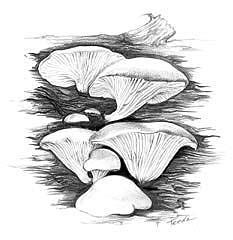Oyster Mushroom
Pleurotus ostreatus
Knowledgable mushroom lovers all over the world wait until the fall of the year to pursue the robust oyster mushrooms that grow on trees in the wild. Shortly after the first rains of the season, the snow-gray petal-like beginnings of P. ostreatus can be found. The autumn forest is brightened with the delicate, young, translucent, eccentrically stemmed caps cascading shelflike from the surface of dead hardwood trees. The cap is scallop shaped and has a delicate aniselike aroma not usually found in oyster mushrooms grown on artifical material. Occasionally, tan caps will be found, and some of these can spread out to 18 inches in diameter, with thick, meaty flesh. It is possible to gather caps from a single log two or three times in one season.

Fresh oyster mushrooms can now be found in supermarkets and farmer's markets alongside our friendly but less-expensive common store mushroom. Cultivated oyster mushrooms are not only sweet tasting but versatile, because they can be used as a subtle flavoring agent in many ways.
A spectrum of colored Pleurotus has appeared in the marketplace. Gray, blue, yellow, pink, and white caps will please the eye as well as the palate. Members of our society call it the "designer mushroom." Especially delicious is the dark-capped P. sajor-caju, which blends well in a variety of dishes. The stems are tender and tasty, which makes them a good buy.
The most recently introduced cultivated Pleurotus is outstanding: it has delicate daffodil-yellow flowerlike caps with pure white stems, and grows in large clumps. One such group could be used as a centerpiece for a dinner table. The almost fruity aroma reminds one of certain zinfandel red wines, and this sweet quality is not lost in cooking. Prepared in a baked noodle dish, its pleasant flavor mixes with the other ingredients without losing intensity. Try to buy those which have large caps. The small specimens do not have the same fine flavor. Cook the same way as P. ostreatus. The stems of the yellow Pleurotus may be quite bitter to some individuals, in which case they should be removed and discarded.
For do-it-yourselfers, oyster mushrooms can be grown at home on a small scale from kits sold through seed catalogues and gardening magazines.
Occasionally clumps of Pleurocybella porrigens, "angels' wings," are found on coniferous wood. These are slender, smaller, short-stemmed relatives of P. ostreatus. They are encountered over most the United States. Cook and clean them as you would other Pleurotus species.
A few minor intestinal upsets have been reported from eating Pleurotus mushrooms. These are usually mild reactions, such as those some of us have had from eating watermelon, cabbage, etc..
Cleaning
Cut off the lower part of the stems of all oyster varieties, especially when using cultivated caps, to remove any shreds of straw or wood. The stems are tough, so discard them. Be certain to rapidly flush out the gill spaces of wild mushrooms. Insects enjoy this sanctuary. Use a minimum amount of water, since P. ostreatus is naturally quite moist. Gently press between paper or cloth towels to remove excess liquid. All species of Pleurotus are cleaned in the same manner.
Cooking
Oyster mushrooms are used in stir-fried dishes, since the cap is thin and cooks quickly. Asian chefs simply tear the mushroom into desirable sizes before adding it to their woks.
If you prepare a dish that requires a long cooking time, add these mushrooms at the last stage of cooking. Once heated briefly in butter or oil, they add character to a light cream sauce poured over fillets of sole or chicken breasts.
Sometimes very large specimens with flesh more than 1 inch thick are found. These can be cut into large pieces, dipped into slightly beaten eggs, and then rolled in bread crumbs for pan-frying.
Preserving
Store in a freezer after briefly sautéing in butter.
Oyster mushrooms dehydrate rapidly. When used dry, they can be added to a dish without rehydration. Asian stores now offer them in bulk and in packages, fresh or dried.

Hiç yorum yok:
Yorum Gönder